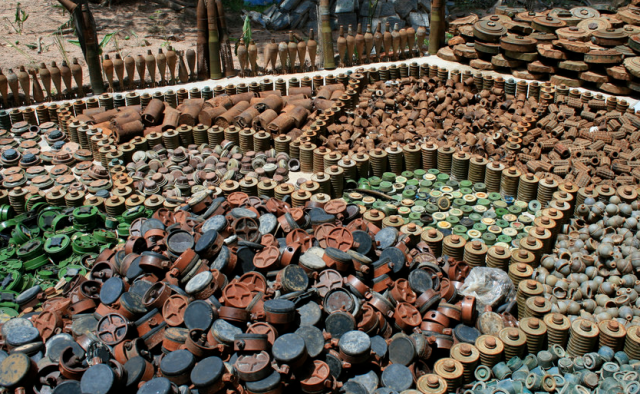
The landmark Ottawa Convention, also known as the Anti-Personnel Mine Ban Treaty, is 20 years old this year, more or less. It was adopted by the UN General Assembly on 8 September 1997, opened for signature on 3 December 1997 and came into force on 1 March 1999.
The treaty was the first example of what has come to be known as humanitarian arms control—when states agree to control commonly used weapons for human rights and human security reasons. Banning cluster munitions, managing small arms, banning excessively injurious conventional weapons and adopting the Arms Trade Treaty are all essentially humanitarian arms control.
Anti-personnel mines injure and kill civilians in large numbers. Whatever their original military purpose, they kill and maim indiscriminately anyone unfortunate enough to step on them. They can lie dormant for years or decades after a conflict has ended. And they can be transported by mudslides and water to areas far from their original location, as the Indian Ocean tsunami of 2004 showed. Ultimately, their victims are often people who had little role in the conflict, let alone fought as combatants.
In 2002, I watched a woman walk calmly past me, past a de-miner and then past a ‘Danger Mines’ sign in Sri Lanka to collect her goat tethered in the field beyond. She made it out intact, with the goat, although there was another tethered in that field. I had no doubt that she made that journey every day, and those landmines would almost certainly have been rearranged in the tsunami.
The groundswell of support across the globe for a ban on anti-personnel mines, even before the treaty was opened for signature, was the result of extensive advocacy by coalitions of non-government organisations that ultimately became the International Campaign to Ban Landmines. The ICBL remains an avid advocate of accession to the Ottawa Convention and continues to hold governments to account through its country studies and an annual public report card, the Landmine Monitor.
Lobbyists from ICBL, along with Princess Diana, were tireless in their attempts to get a legally binding international treaty. Department of Defence and DFAT officials in Canberra remember, with some awe, the persuasive passion of Sister Patricia Pak Poy from the Sisters of Mercy. The success of the campaign to ban anti-personnel mines revolved partly around brilliant community diplomats like Sister Patricia and high-profile advocates like Princess Diana. But also important was the quality research presented to bureaucracies on the numbers of non-military casualties and the brutal randomness of a victim-activated weapon, to which children are chillingly attracted.
Australia has been a strong advocate for banning anti-personnel mines and adopting the convention. Its bureaucracy has been more amenable than those in many other countries. The Australian Army argued in favour of the tactical utility of anti-personnel mines, but Hugh White, the deputy secretary for strategy and intelligence in Defence at the time, recalls the debate swinging in favour of a total ban because of the indiscriminate nature of the weapons, the experiences of personnel involved in demining in Cambodia, and the Australian casualties when landmines laid by Australians were dug up and used against our troops during the Vietnam War.
An impressive 163 nations are parties to the treaty. However, a quick glance at the Landmine and Cluster Munition Monitor’s map of signatory and non-signatory states shows that many of the holdout states are in the Indo-Asia–Pacific. They include our strongest ally, the United States, and the major powers of Russia, China and India. The argument is that landmines retain a strategic utility along the India–Pakistan border, and along the land border between the Koreas. They are also used in conflicts in Myanmar and Yemen.
According to the 2017 Landmine Monitor report, after three years of declining funding for activities to reduce the social, economic and environmental impact of landmines, support from donor and hosts states increased in 2016, to US$564.5 million. As of November 2017, 61 countries and regions remained contaminated by anti-personnel mines in some way. Despite extensive clearing over recent decades, massive areas are still strewn with mines, including hundreds of square kilometres in each of Afghanistan, Angola, Azerbaijan, Bosnia and Herzegovina, Cambodia, Chad, Croatia, Iraq, Thailand and Turkey. The number of victims continued to increase in 2016, with 8,605 casualties, including 2,069 deaths, from mines or other ‘explosive remnants of war’. That’s the highest number since detailed recordkeeping began in 1999. Casualties were recorded in 56 countries and regions; 78% were civilians and at least 42% were children.
On the other hand, nations that have signed the treaty destroyed stockpiles of over 2 million mines in 2015. Almost 158,000 more mines were destroyed in clearance operations, an intensely laborious activity.
So, is the treaty a success? The academic argument is that its profound normative influence and the vilification of mines is success enough. Even armed groups can sign an equivalent non-use agreement. Lives have been saved, significant support for victims continues, and the raft of other humanitarian arms control agreements spawned by the treaty is a considerable legacy. The 20th anniversary of the Ottawa Convention is certainly worth celebrating.

